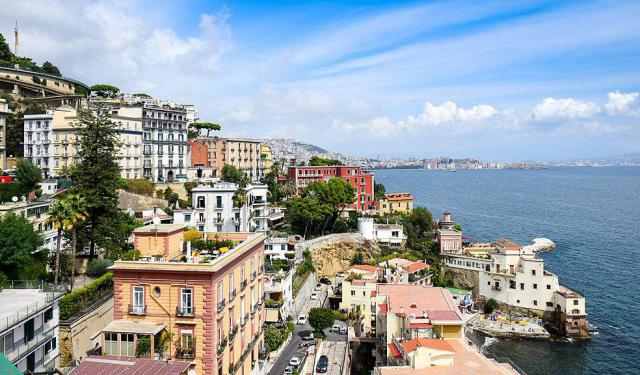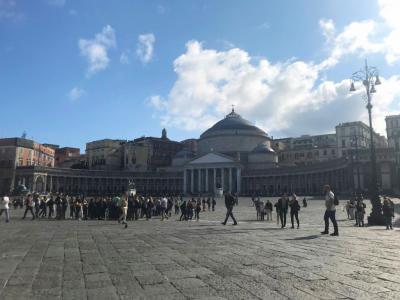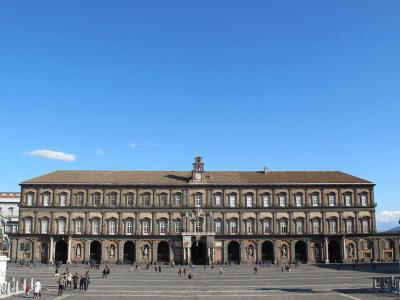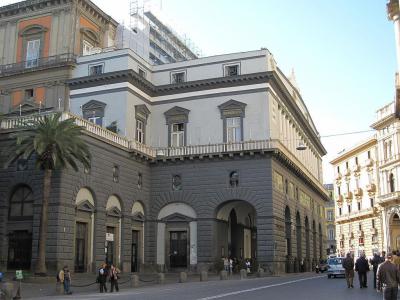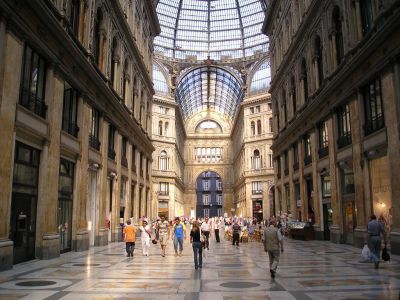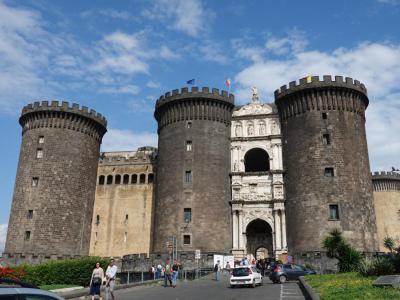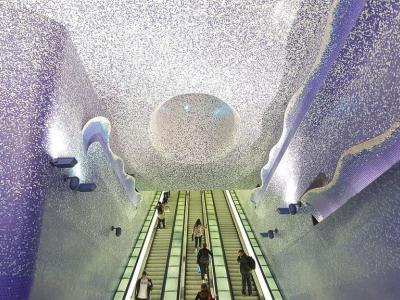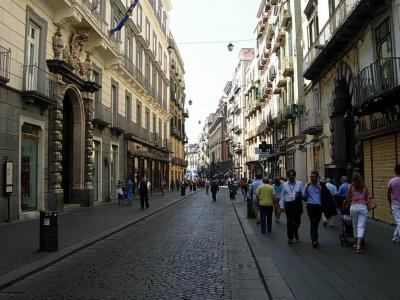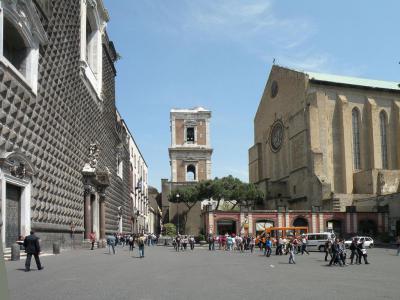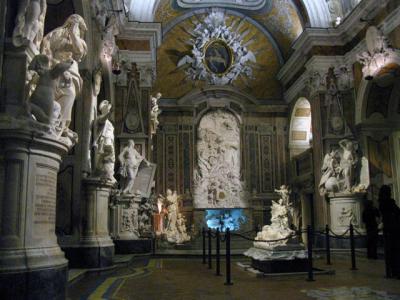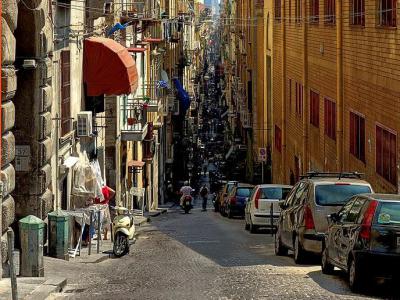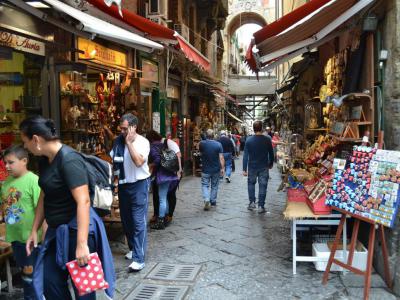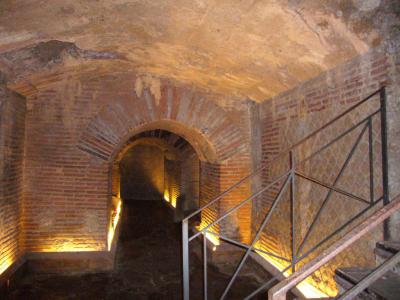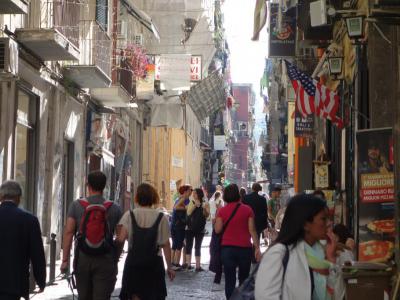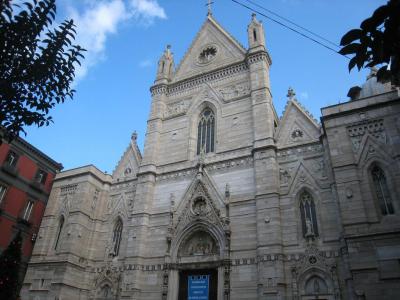Naples Introduction Walking Tour (Self Guided), Naples
Located nearby the infamous volcano Vesuvius, Naples is a dream destination for tourists. Being Italy's third largest city, it is also one of the oldest continuously inhabited urban areas in the world – a true gem of ancient civilizations. Initially settled by Greeks as a colony, called Parthenope, in the 9th century BC, it was then re-founded as Neápolis (“New City” in Greek) three centuries later.
The city served as the capital of the Duchy of Naples (661–1139), then of the Kingdom of Naples (1282–1816), and finally of the Two Sicilies until the unification of Italy in 1861. Naples is also considered the capital of Baroque, courtesy of the 17th-century artist Caravaggio who worked here and inspired an artistic revolution.
Between 1925 and 1936, under Benito Mussolini, Naples was expanded and upgraded. During World War II it sustained severe damage from Allied bombing, and saw extensive reconstruction in the postwar period. Since the late 20th century, the city has enjoyed significant economic growth. In 1995, its historic center was listed as a UNESCO World Heritage Site.
Naples' almost three millennia-long history has left it a wealth of historic buildings and monuments – predominantly Medieval, Renaissance and Baroque styles, – largely contributing its magical landscape.
The main square – Piazza del Plebiscito – was originally designed as a tribute to Napoleon and was named after the plebiscite of 1860 that brought Naples into the Kingdom of Italy. Bounding the piazza is the Royal Palace; nearby is Teatro di San Carlo, the oldest opera house in Italy. Directly across from the theater is Galleria Umberto I, a shopping center and social hub.
Naples is well known for its historic castles, such as the 13th-century Castel Nuovo, aka Maschio Angioino – one of the city's foremost landmarks, built under Charles I, the first king of Naples.
Underneath the city there are series of caves and structures created by centuries of mining, which are now an attraction in their own right.
Naples has a total of 1,000 churches, a good half of which are historic, like the Duomo di Napoli (Naples Cathedral), seat of the Archdiocese of Naples. Widely known as the Duomo di San Gennaro, each year on 19 September, this church hosts the longstanding Miracle of Saint Januarius, the city's patron saint.
To explore these and other culturally and historically significant sights of Naples, embark on our self-guided introductory walk.
The city served as the capital of the Duchy of Naples (661–1139), then of the Kingdom of Naples (1282–1816), and finally of the Two Sicilies until the unification of Italy in 1861. Naples is also considered the capital of Baroque, courtesy of the 17th-century artist Caravaggio who worked here and inspired an artistic revolution.
Between 1925 and 1936, under Benito Mussolini, Naples was expanded and upgraded. During World War II it sustained severe damage from Allied bombing, and saw extensive reconstruction in the postwar period. Since the late 20th century, the city has enjoyed significant economic growth. In 1995, its historic center was listed as a UNESCO World Heritage Site.
Naples' almost three millennia-long history has left it a wealth of historic buildings and monuments – predominantly Medieval, Renaissance and Baroque styles, – largely contributing its magical landscape.
The main square – Piazza del Plebiscito – was originally designed as a tribute to Napoleon and was named after the plebiscite of 1860 that brought Naples into the Kingdom of Italy. Bounding the piazza is the Royal Palace; nearby is Teatro di San Carlo, the oldest opera house in Italy. Directly across from the theater is Galleria Umberto I, a shopping center and social hub.
Naples is well known for its historic castles, such as the 13th-century Castel Nuovo, aka Maschio Angioino – one of the city's foremost landmarks, built under Charles I, the first king of Naples.
Underneath the city there are series of caves and structures created by centuries of mining, which are now an attraction in their own right.
Naples has a total of 1,000 churches, a good half of which are historic, like the Duomo di Napoli (Naples Cathedral), seat of the Archdiocese of Naples. Widely known as the Duomo di San Gennaro, each year on 19 September, this church hosts the longstanding Miracle of Saint Januarius, the city's patron saint.
To explore these and other culturally and historically significant sights of Naples, embark on our self-guided introductory walk.
How it works: Download the app "GPSmyCity: Walks in 1K+ Cities" from Apple App Store or Google Play Store to your mobile phone or tablet. The app turns your mobile device into a personal tour guide and its built-in GPS navigation functions guide you from one tour stop to next. The app works offline, so no data plan is needed when traveling abroad.
Naples Introduction Walking Tour Map
Guide Name: Naples Introduction Walking Tour
Guide Location: Italy » Naples (See other walking tours in Naples)
Guide Type: Self-guided Walking Tour (Sightseeing)
# of Attractions: 14
Tour Duration: 2 Hour(s)
Travel Distance: 3.7 Km or 2.3 Miles
Author: vickyc
Sight(s) Featured in This Guide:
Guide Location: Italy » Naples (See other walking tours in Naples)
Guide Type: Self-guided Walking Tour (Sightseeing)
# of Attractions: 14
Tour Duration: 2 Hour(s)
Travel Distance: 3.7 Km or 2.3 Miles
Author: vickyc
Sight(s) Featured in This Guide:
- Piazza del Plebiscito (Public Square)
- Royal Palace
- Teatro di San Carlo (San Carlo Theatre)
- Galleria Umberto I
- Castel Nuovo (New Castle)
- Toledo Station of the Naples Metro
- Via Toledo (Toledo Street)
- Santa Chiara Complex
- Museo Cappella Sansevero (Sansevero Chapel Museum)
- Spaccanapoli Street
- Via San Gregorio Armeno (St. Gregory of Armenia Street)
- Naples Underground
- Via dei Tribunali (Tribunal Street)
- Duomo di Napoli (Naples Cathedral)
1) Piazza del Plebiscito (Public Square) (must see)
The Piazza Plebiscito is a square named after the plebiscite that resulted in the 1860 unification of Italy. It is the largest square in Naples.
The Piazza Plebiscito was laid under the orders of Joachim Murat, the brother in law of Napoleon who was installed as the King of Naples after the defeat of the Bourbon rulers. He ordered the demolition of an ancient abbey and a church to make way for the square. When the Bourbons returned to power after the defeat of Napoleon, Ferdinand I, the reinstated Bourbon ruler, completed the unfinished Piazza.
After World War II, the square was neglected and became a large parking lot until 1997, when it was restored to its former glory for the G7 summit held in Naples.
The Piazza Plebiscito has a semicircular shape. It has the Royal Palace at one end and the church of San Francesco di Paola on the other. The equestrian statues of the Bourbon kings, Ferdinand I and Charles III are placed in front of the church. Today, the square hosts New Years Eve and other festival celebrations and events like rock concerts. Large installations of contemporary art are also placed here periodically.
The Piazza Plebiscito was laid under the orders of Joachim Murat, the brother in law of Napoleon who was installed as the King of Naples after the defeat of the Bourbon rulers. He ordered the demolition of an ancient abbey and a church to make way for the square. When the Bourbons returned to power after the defeat of Napoleon, Ferdinand I, the reinstated Bourbon ruler, completed the unfinished Piazza.
After World War II, the square was neglected and became a large parking lot until 1997, when it was restored to its former glory for the G7 summit held in Naples.
The Piazza Plebiscito has a semicircular shape. It has the Royal Palace at one end and the church of San Francesco di Paola on the other. The equestrian statues of the Bourbon kings, Ferdinand I and Charles III are placed in front of the church. Today, the square hosts New Years Eve and other festival celebrations and events like rock concerts. Large installations of contemporary art are also placed here periodically.
2) Royal Palace (must see)
The Royal Palace is located opposite the Basilica of San Francesco di Paola on the Piazza Plebiscito. It was used as a residence by the Bourbon kings who ruled Naples between 1730 and 1860.
The palace is on the site of an earlier residence, which had housed the former viceroy Don Pedro de Toledo, Marquis of Villafranca. Construction on the present building was begun in the 17th century by the architect Domenico Fontana. It was intended to house the King Philip III of Spain on his visit to this part of his kingdom. However the visit never materialized. Instead the palace initially housed the Viceroy Fernando Ruiz de Castro, count of Lemos.
In 1734, with the arrival of Charles III of Spain to Naples, the palace became the royal residence of the Bourbons. It was greatly expanded and embellished during the reign of King Ferdinand II. The most recent refurbishment was after the damage caused to the structure during World War II.
Today the Royal Palace houses the National Library of Naples, several city offices including the tourist office and a small museum. A magnificent double staircase takes visitors up to the former royal apartments with their lavish furniture and furnishings. The Royal Chapel has a large 18th century Nativity scene that is regarded as the building’s art treasure.
The National Library of Naples has an impressive collection of papyrus scrolls found during excavations at Herculaneum and a 5th century Coptic Bible. The western facade of the palace that faces the Piazza Plebiscito has statues of many of the kings from different dynasties that ruled Naples from the 12th century.
The palace is on the site of an earlier residence, which had housed the former viceroy Don Pedro de Toledo, Marquis of Villafranca. Construction on the present building was begun in the 17th century by the architect Domenico Fontana. It was intended to house the King Philip III of Spain on his visit to this part of his kingdom. However the visit never materialized. Instead the palace initially housed the Viceroy Fernando Ruiz de Castro, count of Lemos.
In 1734, with the arrival of Charles III of Spain to Naples, the palace became the royal residence of the Bourbons. It was greatly expanded and embellished during the reign of King Ferdinand II. The most recent refurbishment was after the damage caused to the structure during World War II.
Today the Royal Palace houses the National Library of Naples, several city offices including the tourist office and a small museum. A magnificent double staircase takes visitors up to the former royal apartments with their lavish furniture and furnishings. The Royal Chapel has a large 18th century Nativity scene that is regarded as the building’s art treasure.
The National Library of Naples has an impressive collection of papyrus scrolls found during excavations at Herculaneum and a 5th century Coptic Bible. The western facade of the palace that faces the Piazza Plebiscito has statues of many of the kings from different dynasties that ruled Naples from the 12th century.
3) Teatro di San Carlo (San Carlo Theatre)
The San Carlo Theatre is the main opera house of the city of Naples. It has been the venue of major productions by well known composers throughout its history.
The San Carlo Theatre was commissioned by the Bourbon King Charles VII of Naples and designed by the architect, Antonio Medrano. The building had a neoclassical style with gilded interiors and blue upholstered seats. The theater opened in 1737 with the performance of Domenico Sarro's, ‘Achille in Sciro’, based on a play by the poet and playwright, Metastasio. The original structure was damaged by a fire in 1816 and rebuilt within ten months by the architect, Antonio Niccolini under the orders of another Bourbon monarch, King Ferdinand IV.
The San Carlo Theatre remains the oldest continuously active opera house in Europe. The theater’s museum has exhibits tracing the history of the building and the many great productions that it has hosted. It can seat an audience of 1,470 and its acoustics are regarded as one of the best among opera houses in Italy. It has hosted productions of internationally famous composers like Giuseppe Verdi, Donizetti and Rossini. A guided tour is available in English that takes visitors around the theater and backstage.
The San Carlo Theatre was commissioned by the Bourbon King Charles VII of Naples and designed by the architect, Antonio Medrano. The building had a neoclassical style with gilded interiors and blue upholstered seats. The theater opened in 1737 with the performance of Domenico Sarro's, ‘Achille in Sciro’, based on a play by the poet and playwright, Metastasio. The original structure was damaged by a fire in 1816 and rebuilt within ten months by the architect, Antonio Niccolini under the orders of another Bourbon monarch, King Ferdinand IV.
The San Carlo Theatre remains the oldest continuously active opera house in Europe. The theater’s museum has exhibits tracing the history of the building and the many great productions that it has hosted. It can seat an audience of 1,470 and its acoustics are regarded as one of the best among opera houses in Italy. It has hosted productions of internationally famous composers like Giuseppe Verdi, Donizetti and Rossini. A guided tour is available in English that takes visitors around the theater and backstage.
4) Galleria Umberto I
The Galleria Umberto is a public shopping arcade in Naples located opposite the San Carlo opera house. It was named after King Umberto I, who was the King of Italy at the time of its construction.
The Galleria Umberto was designed by architect, Emanuele Rocco and built between 1887 and 1891. It was meant to be a residential and commercial complex and has one of the largest glass roofs in the world. It was the most famous structures constructed during the ten-year Rebuilding of Naples that ended with the beginning of World War I.
The Galleria Umberto has three floors topped by a 184 feet tall arched dome. The dome is supported by 16 metal ribs. The arcade is designed in the shape of a cross with a beautiful mosaic depicting the signs of the Zodiac at the center of the floor. Shops, cafes and offices occupy the first and second floors and the third floor has residential apartments. It consists of four glass roofed wings. One wing opens to the main thoroughfare of the city, the Via Toledo and another opens to the San Carlo Theatre. The Galleria Umberto is the setting of the book, ‘The Gallery’, by John Horne Burns about life in occupied Naples in 1944 after World War II.
Tip:
The food here is amazing – you cannot go wrong with pizza and pastries.
The Galleria Umberto was designed by architect, Emanuele Rocco and built between 1887 and 1891. It was meant to be a residential and commercial complex and has one of the largest glass roofs in the world. It was the most famous structures constructed during the ten-year Rebuilding of Naples that ended with the beginning of World War I.
The Galleria Umberto has three floors topped by a 184 feet tall arched dome. The dome is supported by 16 metal ribs. The arcade is designed in the shape of a cross with a beautiful mosaic depicting the signs of the Zodiac at the center of the floor. Shops, cafes and offices occupy the first and second floors and the third floor has residential apartments. It consists of four glass roofed wings. One wing opens to the main thoroughfare of the city, the Via Toledo and another opens to the San Carlo Theatre. The Galleria Umberto is the setting of the book, ‘The Gallery’, by John Horne Burns about life in occupied Naples in 1944 after World War II.
Tip:
The food here is amazing – you cannot go wrong with pizza and pastries.
5) Castel Nuovo (New Castle) (must see)
The New Castle is not new, it is a large medieval castle first built in 1279. Its scenic location and imposing size make the castle one of the main architectural landmarks of the city. It was a royal seat for kings of Naples, Aragon and Spain until 1815.
Commissioned by Charles I of Anjou and built between 1279-82 as the royal residence after the capital of the Sicily Kingdom shifted from Palermo to Naples, it became the venue for all important events during the rule of the Angevin dynasty. The Spanish Aragon dynasty that ruled Naples after the Angevins improved the structure and used it both as a royal residence and a military fortress. The marble entrance arch was created by sculptors from Catalonia in Spain to celebrate the beginning of the Aragonese rule of Naples.
The New Castle has housed the Neapolitan Society of National History since 1875 and the Civic Museum that contains works of art from churches around Naples. It is open for public viewing and managed by the Naples Ministry of Culture. Among the things to see are a display of weapons in the armory hall and the Palatine or Saint Barbara chapel located within the castle. Cultural events and exhibitions are held at the two levels of the southern courtyard and at the Charles V Hall and the Salla della Loggia inside the castle.
The castle is truly breathtaking when observing it from outside. Massive and beautiful, it can really impress. Make sure to visit the excavations underground and also take the elevator/stairs to the top, where the city view is extensive.
Tip:
If you go, it is highly recommended that you join a guided tour, if you want to make most of your visit - the small extra fee is worth it.
Commissioned by Charles I of Anjou and built between 1279-82 as the royal residence after the capital of the Sicily Kingdom shifted from Palermo to Naples, it became the venue for all important events during the rule of the Angevin dynasty. The Spanish Aragon dynasty that ruled Naples after the Angevins improved the structure and used it both as a royal residence and a military fortress. The marble entrance arch was created by sculptors from Catalonia in Spain to celebrate the beginning of the Aragonese rule of Naples.
The New Castle has housed the Neapolitan Society of National History since 1875 and the Civic Museum that contains works of art from churches around Naples. It is open for public viewing and managed by the Naples Ministry of Culture. Among the things to see are a display of weapons in the armory hall and the Palatine or Saint Barbara chapel located within the castle. Cultural events and exhibitions are held at the two levels of the southern courtyard and at the Charles V Hall and the Salla della Loggia inside the castle.
The castle is truly breathtaking when observing it from outside. Massive and beautiful, it can really impress. Make sure to visit the excavations underground and also take the elevator/stairs to the top, where the city view is extensive.
Tip:
If you go, it is highly recommended that you join a guided tour, if you want to make most of your visit - the small extra fee is worth it.
6) Toledo Station of the Naples Metro
The Toledo Station won the 2013 Leaf Award as the Public Building of the Year. This impressive metro station was part of the Art Stations project, aimed at bringing art into people's daily lives. The Toledo Station is the most dazzling of the art installations and was nominated as the most beautiful transit station in Europe.
Visitors will notice three hexagonal pyramids outside the station. The Knight of Toledo, a steel statue, guards one of the entrances.
At 130 feet underground, the Toledo Station is one of the deepest stations in Naples. As you descend on the escalator, you will notice that each level has a different color representing a different theme.
The first floor is black, representing the asphalt of busy city life. Remains of ancient walls are included on the first floor. The atrium is decorated with mosaic tiles that depict historical scenes. One scene shows Saint Gennaro, Naple's patron saint, leading a procession. The second scene shows the construction of the subway.
Yellow and ochre walls portray the bright Naples sun and volcanic tuff. As visitors continue to descend, the colors turn blue and green to represent the sea. An 80-foot long LED-lit installation shows an image of the sea with continuous waves on the quay floor.
Visitors will notice three hexagonal pyramids outside the station. The Knight of Toledo, a steel statue, guards one of the entrances.
At 130 feet underground, the Toledo Station is one of the deepest stations in Naples. As you descend on the escalator, you will notice that each level has a different color representing a different theme.
The first floor is black, representing the asphalt of busy city life. Remains of ancient walls are included on the first floor. The atrium is decorated with mosaic tiles that depict historical scenes. One scene shows Saint Gennaro, Naple's patron saint, leading a procession. The second scene shows the construction of the subway.
Yellow and ochre walls portray the bright Naples sun and volcanic tuff. As visitors continue to descend, the colors turn blue and green to represent the sea. An 80-foot long LED-lit installation shows an image of the sea with continuous waves on the quay floor.
7) Via Toledo (Toledo Street)
Toledo Street is another ancient street that is home to many important landmarks. Toledo Street is three-quarters of a mile long and runs from Piazza Dante to Piazza Trieste e Trento. The street was first created in 1536 and gained popularity as a traditional Grand Tour stop.
Toledo Street is a pedestrian-only destination for shopping. Here, you can find Italian-inspired clothing items from boutiques or chain stores. The Galleria Umberto is one of Italy's most popular shopping arcades and is decorated with sculptures and murals. The gallery has shops, restaurants, and cafes. You can't miss the impressive domed glass and steel roof that fills the gallery with natural light.
Several museums and historical buildings line Toledo Street. The San Carlo Theatre was first opened in 1737 and is the oldest continuously running opera house in the world. The Royal Palace of Naples was originally built in the 1600s and displays the luxurious live of Naples' royals.
Toledo Street is a pedestrian-only destination for shopping. Here, you can find Italian-inspired clothing items from boutiques or chain stores. The Galleria Umberto is one of Italy's most popular shopping arcades and is decorated with sculptures and murals. The gallery has shops, restaurants, and cafes. You can't miss the impressive domed glass and steel roof that fills the gallery with natural light.
Several museums and historical buildings line Toledo Street. The San Carlo Theatre was first opened in 1737 and is the oldest continuously running opera house in the world. The Royal Palace of Naples was originally built in the 1600s and displays the luxurious live of Naples' royals.
8) Santa Chiara Complex (must see)
The Santa Chiara Complex is home to several religious buildings, including the Church of Santa Chiara, an archeological museum, tombs, and a monastery.
The complex was built by Queen Sancha of Majorca and King Robert of Naples in 1310. King Robert is buried in the complex.
The Church of Santa Chiara was originally built in Provençal-Gothic style; it was updated to the Baroque style in the 18th century. It was restored again after being damaged during World War II.
The west facade of the church has a central rose window but is otherwise plain. The interior is the largest in Naples, with ten chapels. The chapels have superb Gothic monuments.
The complex was built to hold the royal Anjou tombs. Joan I was buried here in 1382.
The church's cloisters are stunning. Seventy-two columns line the garden walkways. A series of benches connect these columns. The columns and benches are decorated with 18th century hand-painted Majorca tiles. Each tile is unique, and together the tiles show various scenes. Elaborate vines and flowers climb the pillars. Scenes show rural life and fishermen with their Mediterranean catch.
The cloister's porticoes have hand-painted 17th-century frescoes decorating the ceilings.
The gardens are filled with citrus and lavender trees. Visitors will also find a fountain in the middle of a Middle Age friar's refectory.
The museum features the ruins of a first-century Roman spa and sauna. Visitors will also find various ecclesiastical artifacts and historical displays in the museum.
Why You Should Visit:
This complex shows the dedication of King Robert the Wise and Queen Sancha to their saints, Saint Francis of Assisi and Saint Chiara. The beautiful cloisters are the biggest draw but don't miss the impressive church and well-preserved Roman ruins.
Tips:
The Cloisters get busier throughout the day. Arrive early and walk through the cloisters first.
The complex was built by Queen Sancha of Majorca and King Robert of Naples in 1310. King Robert is buried in the complex.
The Church of Santa Chiara was originally built in Provençal-Gothic style; it was updated to the Baroque style in the 18th century. It was restored again after being damaged during World War II.
The west facade of the church has a central rose window but is otherwise plain. The interior is the largest in Naples, with ten chapels. The chapels have superb Gothic monuments.
The complex was built to hold the royal Anjou tombs. Joan I was buried here in 1382.
The church's cloisters are stunning. Seventy-two columns line the garden walkways. A series of benches connect these columns. The columns and benches are decorated with 18th century hand-painted Majorca tiles. Each tile is unique, and together the tiles show various scenes. Elaborate vines and flowers climb the pillars. Scenes show rural life and fishermen with their Mediterranean catch.
The cloister's porticoes have hand-painted 17th-century frescoes decorating the ceilings.
The gardens are filled with citrus and lavender trees. Visitors will also find a fountain in the middle of a Middle Age friar's refectory.
The museum features the ruins of a first-century Roman spa and sauna. Visitors will also find various ecclesiastical artifacts and historical displays in the museum.
Why You Should Visit:
This complex shows the dedication of King Robert the Wise and Queen Sancha to their saints, Saint Francis of Assisi and Saint Chiara. The beautiful cloisters are the biggest draw but don't miss the impressive church and well-preserved Roman ruins.
Tips:
The Cloisters get busier throughout the day. Arrive early and walk through the cloisters first.
9) Museo Cappella Sansevero (Sansevero Chapel Museum) (must see)
The Sansevero Chapel Museum is also known as the Chapel of Santa Maria della Pietà, named for a painting of the Virgin Mary.
The painting has a unique backstory. In the late 16th century, an innocent man was sent to prison. He was released thanks to the miraculous appearance of the Virgin Mary. The innocent man commissioned a painting, The Pietà. Soon, pilgrims flocked to view the painting. One of the pilgrims was John Francesco di Sangro, who was cured of an illness after viewing the painting.
He was so inspired by this miracle that, in 1590, he built a private chapel, which would later be used as a family burial chapel. Raimondo di Sangro, Prince of Sansevero, was responsible for renovating the chapel and commissioning the famous artwork that visitors see today.
The chapel is home to nearly thirty important artworks. Artist Antonio Corradini created The Veiled Truth in 1752 as a monument to Cecilia Gaetani dell'Aquila d'Aragona, Raimondo's mother.
Giuseppe Sanmartino created The Veiled Christ in 1753. This stunning masterpiece was chiseled from marble and shows Christ's suffering body lying under a transparent shroud.
Francesco Queirolo's 1754 The Release from Deception was created as a monument to Raimondo's father. This statue shows a man wrestling a net that entangles him.
Surrounding The Veiled Christ are statues representing different virtues such as modesty, liberality, marital sweetness, education, and self-control.
Francesco Maria Russo painted The Glory of Paradise on the ceiling in 1749. The floor was originally in a black and white labyrinth design.
The chapel also has two unusual displays of preserved skeletons with silk and wax blood vessels and arteries.
Why You Should Visit:
The Sansevero Chapel Museum holds artwork by the most prominent 18th-century Italian artists. The chapel is unassuming on the outside but has a hauntingly beautiful and captivating interior.
Tips:
Make sure you use the audio guide to get the most out of your visit.
The painting has a unique backstory. In the late 16th century, an innocent man was sent to prison. He was released thanks to the miraculous appearance of the Virgin Mary. The innocent man commissioned a painting, The Pietà. Soon, pilgrims flocked to view the painting. One of the pilgrims was John Francesco di Sangro, who was cured of an illness after viewing the painting.
He was so inspired by this miracle that, in 1590, he built a private chapel, which would later be used as a family burial chapel. Raimondo di Sangro, Prince of Sansevero, was responsible for renovating the chapel and commissioning the famous artwork that visitors see today.
The chapel is home to nearly thirty important artworks. Artist Antonio Corradini created The Veiled Truth in 1752 as a monument to Cecilia Gaetani dell'Aquila d'Aragona, Raimondo's mother.
Giuseppe Sanmartino created The Veiled Christ in 1753. This stunning masterpiece was chiseled from marble and shows Christ's suffering body lying under a transparent shroud.
Francesco Queirolo's 1754 The Release from Deception was created as a monument to Raimondo's father. This statue shows a man wrestling a net that entangles him.
Surrounding The Veiled Christ are statues representing different virtues such as modesty, liberality, marital sweetness, education, and self-control.
Francesco Maria Russo painted The Glory of Paradise on the ceiling in 1749. The floor was originally in a black and white labyrinth design.
The chapel also has two unusual displays of preserved skeletons with silk and wax blood vessels and arteries.
Why You Should Visit:
The Sansevero Chapel Museum holds artwork by the most prominent 18th-century Italian artists. The chapel is unassuming on the outside but has a hauntingly beautiful and captivating interior.
Tips:
Make sure you use the audio guide to get the most out of your visit.
10) Spaccanapoli Street (must see)
Spaccanapoli Street can be translated to "Naples splitter." This long street is popular with locals and visitors alike as it provides access to the most popular landmarks and sights in Naples. The ancient street is actually several different streets, such as Via San Biagio and Via Benedetto Croce.
Along Spaccanapoli Street, visitors will find artist's workshops, overhanging balconies, and narrow through-ways. This is the perfect place to immerse yourself in the daily life of Naples.
At the intersection with Via Duomo, visitors will find sweet local stores, bars, restaurants, shopping boutiques, and vegetable stands.
One of the more unique shops is the L'Ospedale delle Bambole, which specializes in restoring statues and antique dolls. Kids enjoy checking out the doll hospital, complete with doll hospital beds. There's also a museum with antique dolls and toys.
While walking, don't miss the opportunity for a distinctive Naples pizza. Stroll along Spaccanapoli to find several important churches and landmarks. Visitors will find the Church of Gesu Nuovo, the Church of Santa Chiara, the Cappella Sansevero, and the Cathedral of San Gennaro.
Along Spaccanapoli Street, visitors will find artist's workshops, overhanging balconies, and narrow through-ways. This is the perfect place to immerse yourself in the daily life of Naples.
At the intersection with Via Duomo, visitors will find sweet local stores, bars, restaurants, shopping boutiques, and vegetable stands.
One of the more unique shops is the L'Ospedale delle Bambole, which specializes in restoring statues and antique dolls. Kids enjoy checking out the doll hospital, complete with doll hospital beds. There's also a museum with antique dolls and toys.
While walking, don't miss the opportunity for a distinctive Naples pizza. Stroll along Spaccanapoli to find several important churches and landmarks. Visitors will find the Church of Gesu Nuovo, the Church of Santa Chiara, the Cappella Sansevero, and the Cathedral of San Gennaro.
11) Via San Gregorio Armeno (St. Gregory of Armenia Street) (must see)
This ancient street was once home to a temple dedicated to Ceres, a Roman Goddess. The faithful would bring small figurines made in nearby shops to the temple. The tradition continues today as this street became famous for artists that create figurines for Nativity scenes.
Nativity scene creations include different size houses, terracotta shepherds, fruit vendors, or even a pizza vendor. In addition, shoppers can find mechanical items to complete the perfect scene, including windmills and waterfalls.
Today, workshops continue to create religious figures and more modern figures such as famous football players, celebrities, and politicians.
This beautiful, narrow alley is the perfect place to shop for a unique souvenir. Visitors might see the artists at work carving out the next figurine. Via San Gregorio Armeno is busy year-round but absolutely packed with locals and tourists during the Christmas season.
Nativity scene creations include different size houses, terracotta shepherds, fruit vendors, or even a pizza vendor. In addition, shoppers can find mechanical items to complete the perfect scene, including windmills and waterfalls.
Today, workshops continue to create religious figures and more modern figures such as famous football players, celebrities, and politicians.
This beautiful, narrow alley is the perfect place to shop for a unique souvenir. Visitors might see the artists at work carving out the next figurine. Via San Gregorio Armeno is busy year-round but absolutely packed with locals and tourists during the Christmas season.
12) Naples Underground (must see)
An ancient subterranean network lies beneath the city of Naples. Tunnels and caves have been carved from the volcanic rock over the last two and a half thousand years. The Greeks built the 280 mile long network in the fourth century BC to form Neapolis or New City.
The Romans then used the underground area to build aqueducts for water.
Today, visitors can explore this underground network exiting some 120 feet below Naples. Visitors descend a long stairway to view the impressive infrastructure. Naples Underground includes cisterns, catacombs, caverns, roadways, and rail tunnels.
One of the most impressive sights is the Greco-Roman theatre of Neapolis. Roman Emperor Nero had a private dressing room here.
During WWII, the underground was used as an air-raid shelter. Visitors can still see weapons and tanks left over from WWII.
The first Hypogeum Gardens are located in the underground. This experimental garden attempts to grow plants away from light and pollution.
Why You Should Visit:
Naples Underground provides a fascinating and unusual look at Naples' extensive history.
Tips:
Some tunnels are narrow and require a candle or flashlight. If you feel claustrophobic, skip these tunnels.
The Romans then used the underground area to build aqueducts for water.
Today, visitors can explore this underground network exiting some 120 feet below Naples. Visitors descend a long stairway to view the impressive infrastructure. Naples Underground includes cisterns, catacombs, caverns, roadways, and rail tunnels.
One of the most impressive sights is the Greco-Roman theatre of Neapolis. Roman Emperor Nero had a private dressing room here.
During WWII, the underground was used as an air-raid shelter. Visitors can still see weapons and tanks left over from WWII.
The first Hypogeum Gardens are located in the underground. This experimental garden attempts to grow plants away from light and pollution.
Why You Should Visit:
Naples Underground provides a fascinating and unusual look at Naples' extensive history.
Tips:
Some tunnels are narrow and require a candle or flashlight. If you feel claustrophobic, skip these tunnels.
13) Via dei Tribunali (Tribunal Street)
Tribunal Street was the main east-west street during Greek and Roman times. Tribunal Street runs parallel to Spaccanapoli Street and is a vital thoroughfare with a myriad of landmarks.
Tribunal Street is over half a mile long and home to over 20 important churches such as the Naples Cathedral. The ancient street runs from the San Pietro a Maiella Church to the former main Naples courthouse, hence the Tribunal name.
Visitors can also find the San Lorenzo Maggiore Basilica and Monumental Complex on Tribunal Street. Ancient market ruins are visible underneath the complex. Visitors can also access the impressive Naples Underground from Tribunal Street.
As you stroll the cobblestone street, admire the decaying palaces of Naples' nobility.
During the day, visitors can shop at various markets and boutiques. At night, the street comes alive and is the place to go to taste Neapolitan culinary delights.
The street is open for vehicles, so watch out for the stream of mopeds and cars passing by.
Tribunal Street is over half a mile long and home to over 20 important churches such as the Naples Cathedral. The ancient street runs from the San Pietro a Maiella Church to the former main Naples courthouse, hence the Tribunal name.
Visitors can also find the San Lorenzo Maggiore Basilica and Monumental Complex on Tribunal Street. Ancient market ruins are visible underneath the complex. Visitors can also access the impressive Naples Underground from Tribunal Street.
As you stroll the cobblestone street, admire the decaying palaces of Naples' nobility.
During the day, visitors can shop at various markets and boutiques. At night, the street comes alive and is the place to go to taste Neapolitan culinary delights.
The street is open for vehicles, so watch out for the stream of mopeds and cars passing by.
14) Duomo di Napoli (Naples Cathedral) (must see)
Naples Cathedral is also known as The Cathedral of the Assumption of Mary. The church is commonly called Cattedrale di San Gennaro in honor of Saint Januarius.
The construction of the cathedral began in the 13th century and was finally completed in the 14th century. The impressive Gothic cathedral was built on the ruins of previous churches' excavations. Over the years, Greek and Roman artifacts have been found underneath the cathedral.
The neo-Gothic facade wasn't completed until 1905. The interior features a gilded coffered ceiling. Artist Luca Giordano completed the baroque sections of the nave and transept.
Priest and architect Francesco Grimaldi designed the Chapel of the Treasury. Several renowned artists worked on the chapel, which was completed in 1646. Jusepe de Ribera created the stunning Saint Gennaro Escaping the Furnace Unscathed canvas. Giovanni Lanfranco created the magnificent dome fresco. Behind the altar, Saint Januarius's skull and two vials of blood are held in a silver strongbox.
The next chapel contains Saint Januarius's bones in an urn. More of the saint's remains are housed below the altar in the Cappella Carafa chapel.
Visitors will be impressed by the Basilica di Santa Restituta, originally built in the 4th century and renovated in the 17th century. This ancient church holds Europe's oldest baptistry, the Battistero di San Giovanni in Fonte. The baptistry is decorated with 4th-century mosaics.
A vial of blood belonging to revered Saint Januarius is brought out three times a year, and the dried blood usually liquefies. Legend says that when the blood doesn't liquefy, disaster will come to Naples.
Why You Should Visit:
This stunning medieval cathedral holds the miraculous blood of Saint Januarius, priceless artworks, and an early Christian basilica dating to the 4th century. It's a beautiful place to view Italian art and architecture and appreciate Naples' religious culture.
Tips:
The church is closed in the afternoon. Visit between 8:00 am and 12:30 pm, or 4:30 pm and 7:00 pm. The main cathedral is free to enter, but the baptistery charges a small fee.
The construction of the cathedral began in the 13th century and was finally completed in the 14th century. The impressive Gothic cathedral was built on the ruins of previous churches' excavations. Over the years, Greek and Roman artifacts have been found underneath the cathedral.
The neo-Gothic facade wasn't completed until 1905. The interior features a gilded coffered ceiling. Artist Luca Giordano completed the baroque sections of the nave and transept.
Priest and architect Francesco Grimaldi designed the Chapel of the Treasury. Several renowned artists worked on the chapel, which was completed in 1646. Jusepe de Ribera created the stunning Saint Gennaro Escaping the Furnace Unscathed canvas. Giovanni Lanfranco created the magnificent dome fresco. Behind the altar, Saint Januarius's skull and two vials of blood are held in a silver strongbox.
The next chapel contains Saint Januarius's bones in an urn. More of the saint's remains are housed below the altar in the Cappella Carafa chapel.
Visitors will be impressed by the Basilica di Santa Restituta, originally built in the 4th century and renovated in the 17th century. This ancient church holds Europe's oldest baptistry, the Battistero di San Giovanni in Fonte. The baptistry is decorated with 4th-century mosaics.
A vial of blood belonging to revered Saint Januarius is brought out three times a year, and the dried blood usually liquefies. Legend says that when the blood doesn't liquefy, disaster will come to Naples.
Why You Should Visit:
This stunning medieval cathedral holds the miraculous blood of Saint Januarius, priceless artworks, and an early Christian basilica dating to the 4th century. It's a beautiful place to view Italian art and architecture and appreciate Naples' religious culture.
Tips:
The church is closed in the afternoon. Visit between 8:00 am and 12:30 pm, or 4:30 pm and 7:00 pm. The main cathedral is free to enter, but the baptistery charges a small fee.
Walking Tours in Naples, Italy
Create Your Own Walk in Naples
Creating your own self-guided walk in Naples is easy and fun. Choose the city attractions that you want to see and a walk route map will be created just for you. You can even set your hotel as the start point of the walk.
Naples Old Town Walk
The Old Town of Naples is a treasure trove of majestic architecture: historical monuments, mysterious churches, underground catacombs & caves, and beautiful fountains. Some of these landmarks are thousand years old and still preserved in their original condition. Owing to this, UNESCO has declared the area a World Heritage site.
Walking the maze of narrow alleyways to discover Naples’s... view more
Tour Duration: 2 Hour(s)
Travel Distance: 2.7 Km or 1.7 Miles
Walking the maze of narrow alleyways to discover Naples’s... view more
Tour Duration: 2 Hour(s)
Travel Distance: 2.7 Km or 1.7 Miles
Historical Churches
Christianity in general and the Catholic faith in particular have always played an important role in the social and cultural life of Naples. Not everyone knows that the city boasts the highest number of churches in the world – almost 500 historic “houses of God” (1,000 in total) – accumulated over the course of 17(!) centuries. Hence the nickname – “the city of 500 domes”.
And... view more
Tour Duration: 2 Hour(s)
Travel Distance: 3.7 Km or 2.3 Miles
And... view more
Tour Duration: 2 Hour(s)
Travel Distance: 3.7 Km or 2.3 Miles
The Most Popular Cities
/ view all
